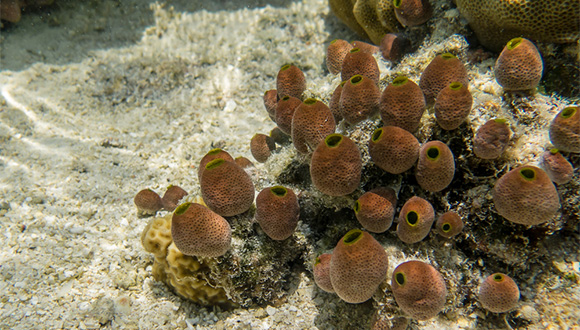A study by Tel Aviv University reveals worrying evidence of environmental contamination
A study led by Prof. Noa Shenkar and graduate student Gal Navon, from the Tel Aviv University (TAU) School of Zoology and the Steinhardt Museum of Natural History, has found significant concentrations of residual pharmaceuticals at 11 sampled sites along the Israeli coastline. These substances have been found in ascidians – marine, filter-feeding, sessile invertebrates.
This study was conducted with the participation of the Hydrochemistry Lab of the Water Research Center of the Porter School of the Environment and Earth Sciences, Raymond & Beverly Sackler Faculty of Exact Sciences, Tel Aviv University, headed by Prof. Dror Avisar. The study was published in the journal “Marine Pollution Bulletin”, in August 2020.
The study involved sampling of ascidians from 9 different sites along the Mediterranean coastline (Achziv, Acre, Haifa Marina, Sdot Yam, Hadera power station, Acadia beach in Herzliya, HaSela beach in Bat-Yam, Ashdod Marina and Ashkelon Marina) and 2 different Red Sea sites (Eilat Marina and Dolphin Reef).
Ascidians are marine invertebrates, few centimetres in size that attach to hard surfaces – such as rocks, peers or breakwaters. Since ascidians feed on small particles found in the water, large quantities of particles from the marine environment accumulate in their bodies over time – including different pollutants. The researchers have performed chemical analysis of the collected ascidians, searching for active compounds of three frequently used pharmaceuticals: Bezafibrate, which reduces blood lipids content; Carbamazepine, an antiepileptic, and mood stabilizer; and Diclofenac, an anti-inflammatory agent present in the well-known medicine Voltaren. These three substances are extremely durable, are hardly degraded by sewage treatment facilities, and last long in the marine environment.
The findings are extremely worrisome: in 10 out of 11 sampled sites significant concentrations of the tested pharmaceuticals have been found.
- All three substances have been detected at 4 of the tested sites (Ashdod, Ashkelon, Sdot Yam and Haifa).
- Residuals of two of the pharmaceuticals have been detected at 5 of the tested sites (Achziv, Acre, Herzliya, Bat-Yam and the Eilat Marina).
- One site – Eilat Dolphin Reef, has shown signs of one pharmaceutical only – Diclofenac, though at a concerning concentration
- Ascidians collected from deep water at the Hadera power station were the only ones to show no traces of pharmaceuticals.
- Especially high concentrations of Diclofenac and Bezafibrate were found in Acre, Ashdod and Ashkelon.

Did they take their medicine today? Ascidians
Prof. Shenkar and the researcher Gal Navon explain that various pharmaceuticals consumed by humans are not fully metabolized in the body, and high percentage of their active compounds are later excreted in their original form. In addition, lack of public awareness often results in the disposal of unused drugs in toilets or home garbage bins. Currently existing sewage treatment facilities are not suitable for the treatment of medication residuals, and, unlike other pollutants, their final concentrations at the endpoint of sewage treatment are not monitored. Eventually, a substantial amount of pharmaceuticals is discharged into the sea by sewage water. According to the research team, a variety of pharmaceutical residuals can be found in marine ecosystems worldwide – antibiotics, anti-inflammatory drugs, analgesics, anti-depressants and many more.
“Many of these compounds are very stable”, the researchers say, “These take a long time to degrade in the marine environment, and the damage they cause to marine life could be extremely excessive, since these pharmaceuticals are designed to affect biological systems (the human body). For example, various studies performed in different sites around the world have shown that Estrogen, present in birth control pills, leads to the development of female features in male fish in certain species, thus damaging their fertility; Prozac triggers increased aggressiveness and risk-taking in crustaceans; anti-depressants impair memory and learning in cuttlefish, and more”.
Prof. Avisar: “We have been studying the chemo-physical fate of drug residuals in groundwater and surface water for the past 15 years, and their detection in marine ecosystems has been surprising. The results indicate a chronic large-scale pharmaceutical residuals contamination, as well as the absorption of micro- and nano-pollutants, measured at very low concentrations in marine organisms”.
“Our study shows that Israel is no stranger to the global serious issue of seawater pharmaceutical contamination.”, Prof. Shenkar concludes. “The medications we use end up in the sea, mainly through sewage discharge, and cause great damage to the marine environment, indirectly affecting humans, who feed on sea foods that are exposed to such contamination. There are different ways to tackle this problem: on the individual level, we recommend that the population as a whole takes personal responsibility, disposing of unused pharmaceuticals into designated containers – which can be found at pharmacies and health maintenance organizations’ facilities. In addition, we are working to expand research on monitoring pharmaceutical contamination along the Israeli coastline, using advanced analysis of a greater variety of widely used medication, while examining the changes exerted upon the various organisms exposed to the environmental concentrations of those pharmaceuticals”.
